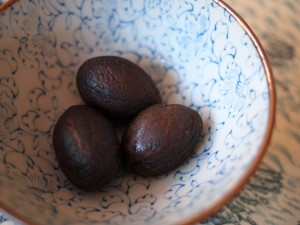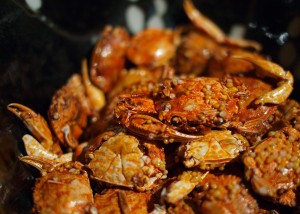
I don’t know whether it’s an effect of culture or genetics, but I’ve noticed that my taste for things which are simultaneously sweet and salty is one not shared by many of my European friends. At the same time, most of my Chinese relations and friends go a bundle for the combination. So over the holidays, hanging out with my Dad and brother (who like their popcorn at the cinema to be a mixture of the salty stuff and the sweet stuff, enjoy peanut brittle, sprinkle salt on guavas and will fight over Mexican candied mango seasoned with a chilli salt), it was inevitable that the snacks which repel my Mum and husband would come out to be nibbled over the sherry.
Chinese candied olives are not something you’re likely to pick up at random while browsing the aisles if you’ve not tried them before, but they’re a great treat; if you like the salty/sweet flavour combination, I think you’ll enjoy them. “Olive” is a bit of a misnomer; they’re not the same species as European olive (Olea europaea). These fruits are Canarium alba, and raw they’re a little like an avocado in texture and flavour, but their similarity in size, shape and their slight oiliness to a European olive is so marked that they’re often mistaken for the European version, especially once processed. That processing is done by soaking the fruit in a dense sugar and salt solution, then part-drying the result. You can buy these olives cracked, so the sugary brine really permeates the flesh, or uncracked for a less intense flavour. The resulting preserve is sweet, with a bit of a salty edge, and a lovely resinous, aromatic flavour. They’re great with a strong drink.

Unfortunately, the caramel crabs I’d bought for drinky nibbles really required a very strong drink indeed before you might be able to manage to choke one down. I usually really rate candied dried fish (there’s a long Malaysian tradition of sweet, dried satay-spiced fish, tiny shrimp and cuttlefish), but this packet of Japanese baby crabs was a long way from being enjoyable. Sawagani are a tiny Japanese river crab, no bigger across the body than the tip of your finger. Some really good Japanese restaurants will drop them live into a deep fryer, and their carapace is so thin that when prepared in this way they turn out a bit like an eight-legged crisp.
Was my packet past its sell-by date? Were my crabs elderly? It’s hard to say – I don’t read any Japanese (and stupidly, I threw the packet out before I had a chance to photograph it, so I can’t ask any Japanese-speakers here to help out), but these were a horrendously fishy little morsel, the shell beneath the layer of mustardy caramel a bit like eating the glaze from your Grandma’s best porcelain. Just say no to caramel crabs. It might be worth buying a packet, though, just to serve with a beer next time you have some friends round as a practical joke.

What a unique mix of flavors. The sweet/salty combination is growing on me, but I don’t think I could have eaten those crabs.
Sugared olives sound great! Where can you find them? In Chinatown?
Yup – you’re more likely to find them in shops which cater to a Southern Chinese audience (some Malaysian shops do them too). They’re a good excuse for a furtle in the darker corners of the store. I was surprised to find that the enormous Wai Yee Hong in Bristol (who I order a lot of Chinese groceries with online) don’t stock them when I was able to get them in a little Chinese supermarket in Cambridge quite easily.
No caramelized crabs with beer for me but deep fried crabs with spicy vinegary and sweet dipping sauce with beer is ok.